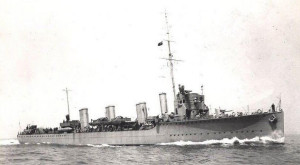Branch of service: Royal Navy, HMS Tipperary
Service No: 283757
Date & place of birth: 12 September 1873 in Heyshott, West Sussex
Date & place of death: 1 June 1916 (aged 42) in Battle of Jutland, North Sea
Isaac Ellcome was a former career sailor who was called up at the start of the war. He was killed at the Battle of Jutland in June 1916.
Family background
Isaac Ellcome was born at Heyshott on 12 September 1873, the ninth of ten children born to James Ellcome (1830–1899) and his wife Frances née Mosley (1836–1926) and was baptised at St James’s Church on 5 October 1873.
James had also been born in Heyshott and married Frances, from Stedham, in St Nicholas’s Church in Brighton in the summer of 1857. Their first child, Edward was born in Brighton about six months later; in all, the couple had ten children (five boys and five girls), with the youngest being Ben, born in 1875. One daughter, Charlotte, died at just over a year old, shortly after Isaac was born; the other children all survived into adulthood.
By 1861, the couple were living at Polecats, near Heyshott, where James worked as an agricultural labourer. They continued to live at Heyshott and by 1881 were living at the Street in the centre of the village, where they were still living ten years later. Following James’s death in 1899, Frances remained in the house at Heyshott Street, possibly until her death in 1926.
At the time of the 1891 census, Isaac (aged 17) was employed as an under carter.
Following the completion of his initial 12 years’ service with the Royal Navy in 1908, Isaac found employment at King Edward VII Sanatorium, Midhurst. This had been opened in June 1906 to care for those suffering from tuberculosis. At the time of the 1911 census, Isaac was living at the sanatorium, where he was employed as a stoker, using the skills he had obtained during his navy service.
Military service
Isaac enlisted at Portsmouth on 12 October 1896, signing on for 12 years. After a year training in Portsmouth as a stoker, he first went to sea in October 1897 on board HMS Camperdown, an Admiral-class battleship, on which he served for two years. He then spent two years on HMS Majestic, a battleship, followed by two years on HMS Indefatigable, an Apollo-class cruiser.
In March 1906, he joined HMS Berwick, a Monmouth-class armoured cruiser until April 1907, having been promoted to Stoker First Class in July 1906. After a short spell ashore, he returned to sea in August 1907 with HMS Forward, a newly-commissioned scout cruiser with the Channel Fleet, where he was to remain until completion of his 12 years’ service in November 1908.
On his discharge, he was transferred to the Royal Navy Reserve. On 2 August 1914, shortly before the war was declared, he re-joined the Royal Navy and spent most of the war on board HMS Tipperary, a Faulknor-class destroyer, joining her immediately after her launch in March 1915. The Faulknor class vessels were originally ordered by the Chilean Navy, but were acquired by the Royal Navy at the outbreak of the war.
HMS Tipperary, under the command of Captain Charles Wintour, led the 4th Destroyer Flotilla, of the Grand Fleet, under the overall command of Admiral Sir John Jellicoe.
Death and commemoration

During the Battle of Jutland, Tipperary and her squadron pressed home torpedo attacks on the German main battle line as it escaped across the rear of the British fleet during the night action, late on 31 May 1916. The 4th Flotilla sank the German light cruiser SMS Frauenlob, butTipperary and many of the other British destroyers were sunk or badly damaged.
HMS Tipperary was sunk on 1 June 1916 by gunfire from the German dreadnought SMS Westfalen, with the loss of 185 hands from her crew of 197, including Isaac Ellcome.
Following the action, Admiral Jellicoe’s report mentioned the loss of HMS Tipperary:
“During the night the British heavy ships were not attacked, but the Fourth, Eleventh and Twelfth Flotillas, under Commodore Hawksley and Captains Charles J. Wintour and Anselan J. B. Stirling, delivered a series of very gallant and successful attacks on the enemy, causing him heavy losses. It was during these attacks that severe losses in the Fourth Flotilla occurred, including that of Tipperary with the gallant leader of the Flotilla, Captain Wintour. He had brought his flotilla to a high pitch of perfection, and although suffering severely from the fire of the enemy, a heavy toll of enemy vessels was taken, and many gallant actions were performed by the flotilla.”
Isaac’s body was never recovered and he is commemorated on The Portsmouth Naval Memorial as well as on the Heyshott war memorial window in St James’s Church.
Other family members and subsequent family history
Isaac’s younger brother, Ben, enlisted in the East Surrey Regiment in June 1897. He served in India between 1898 and 1905, and on the Western front in 1914/15. In January 1916, he was transferred to the Essex Regiment and returned to India until he was discharged in April 1919. Ben died in Surrey in 1942.
Most of Isaac and Ben’s siblings survived until the 1940s or 1950s, with their sister Mary Hannah (Cox) dying in Brighton in 1955.
Isaac appears not to have made a will and he never married. His sister, Louisa (Eldridge) was granted powers of administration of his estate in September 1923, seven years after his death. His estate amounted to just £72 12s 10d.